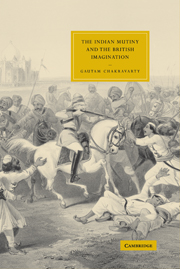Book contents
- Frontmatter
- Contents
- Acknowledgements
- Glossary
- Introduction
- 1 From chronicle to history
- 2 Reform and revision
- 3 Romances of empire, Romantic orientalism and Anglo-India: contexts, historical and literary
- 4 The ‘Mutiny’ novel and the historical archive
- 5 Counter-insurgency and heroism
- 6 Imagining resistance
- Epilogue
- Notes
- Bibliography
- Index list
- CAMBRIDGE STUDIES IN NINETEENTH-CENTURY LITERATURE AND CULTURE
1 - From chronicle to history
Published online by Cambridge University Press: 22 September 2009
- Frontmatter
- Contents
- Acknowledgements
- Glossary
- Introduction
- 1 From chronicle to history
- 2 Reform and revision
- 3 Romances of empire, Romantic orientalism and Anglo-India: contexts, historical and literary
- 4 The ‘Mutiny’ novel and the historical archive
- 5 Counter-insurgency and heroism
- 6 Imagining resistance
- Epilogue
- Notes
- Bibliography
- Index list
- CAMBRIDGE STUDIES IN NINETEENTH-CENTURY LITERATURE AND CULTURE
Summary
Whatever brings you in contact with a greater number of states, increases, in the same proportion, those clashings of interest and pride out of which the pretexts for war are frequently created.
James Mill, ‘Colonies’ (1824)War makes rattling good history.
Thomas Hardy, The Dynasts (1910)CHRONICLE TO HISTORY
Well before the Queen's Proclamation read by Governor-General Canning at Allahabad on 1 November 1858 marked an official end of the rebellion, G. B. Malleson wrote the first part of The Mutiny of the Bengal Army: A Historical Narrative, which appeared in June 1857, only two months after the first uprising at the Meerut garrison. The same year two more accounts of the war in progress appeared: J. F. Lee and Captain F. W. Radcliffe co-authored The Indian Mutiny up to the Relief of Lucknow, which may have preceded Malleson's anonymous pamphlet, and Thomas Frost edited the Complete Narrative of the Mutiny in India from its Commencement to the Present Time. More substantive accounts appeared from 1859, notably the History of the Indian Mutiny by Charles Ball, the Chambers History of the Indian Revolt, E. H. Nolan's Illustrated History of the British Empire in India and the East and The Indian Empire with a Full Account of the Mutiny by Robert Montgomery Martin. Published within two or three years of the rebellion, these comprehensive accounts of events and causes sometimes appended the two rebellious years to a narrative that began with the Macedonian invasion of north-west India in the third century bce.
- Type
- Chapter
- Information
- The Indian Mutiny and the British Imagination , pp. 19 - 48Publisher: Cambridge University PressPrint publication year: 2005

